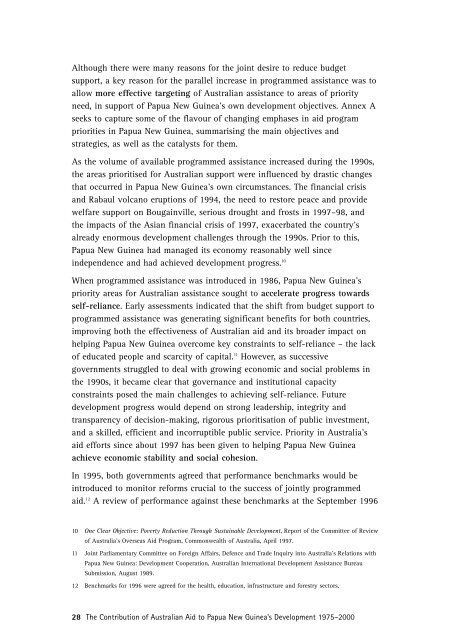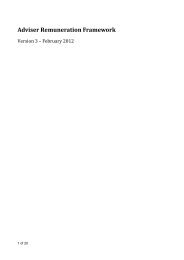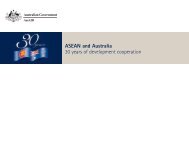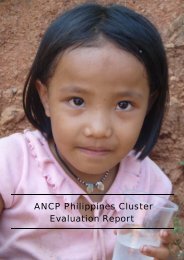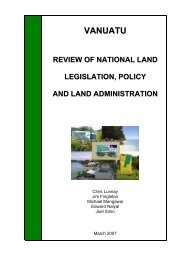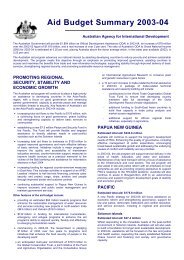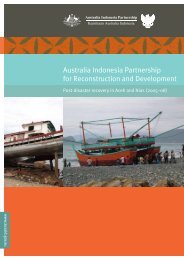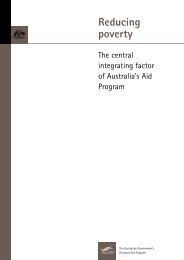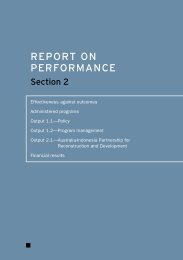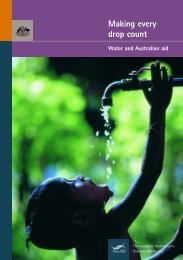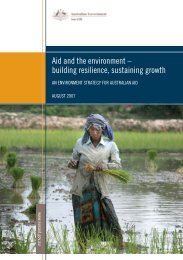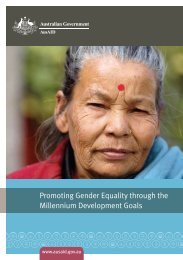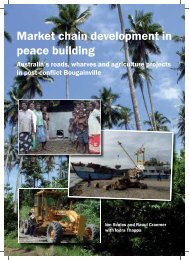Australian Aid to PNG - AusAID
Australian Aid to PNG - AusAID
Australian Aid to PNG - AusAID
Create successful ePaper yourself
Turn your PDF publications into a flip-book with our unique Google optimized e-Paper software.
Although there were many reasons for the joint desire <strong>to</strong> reduce budgetsupport, a key reason for the parallel increase in programmed assistance was <strong>to</strong>allow more effective targeting of <strong>Australian</strong> assistance <strong>to</strong> areas of priorityneed, in support of Papua New Guinea’s own development objectives. Annex Aseeks <strong>to</strong> capture some of the flavour of changing emphases in aid programpriorities in Papua New Guinea, summarising the main objectives andstrategies, as well as the catalysts for them.As the volume of available programmed assistance increased during the 1990s,the areas prioritised for <strong>Australian</strong> support were influenced by drastic changesthat occurred in Papua New Guinea’s own circumstances. The financial crisisand Rabaul volcano eruptions of 1994, the need <strong>to</strong> res<strong>to</strong>re peace and providewelfare support on Bougainville, serious drought and frosts in 1997–98, andthe impacts of the Asian financial crisis of 1997, exacerbated the country’salready enormous development challenges through the 1990s. Prior <strong>to</strong> this,Papua New Guinea had managed its economy reasonably well sinceindependence and had achieved development progress. 10When programmed assistance was introduced in 1986, Papua New Guinea’spriority areas for <strong>Australian</strong> assistance sought <strong>to</strong> accelerate progress <strong>to</strong>wardsself-reliance. Early assessments indicated that the shift from budget support <strong>to</strong>programmed assistance was generating significant benefits for both countries,improving both the effectiveness of <strong>Australian</strong> aid and its broader impact onhelping Papua New Guinea overcome key constraints <strong>to</strong> self-reliance – the lackof educated people and scarcity of capital. 11 However, as successivegovernments struggled <strong>to</strong> deal with growing economic and social problems inthe 1990s, it became clear that governance and institutional capacityconstraints posed the main challenges <strong>to</strong> achieving self-reliance. Futuredevelopment progress would depend on strong leadership, integrity andtransparency of decision-making, rigorous prioritisation of public investment,and a skilled, efficient and incorruptible public service. Priority in Australia’said efforts since about 1997 has been given <strong>to</strong> helping Papua New Guineaachieve economic stability and social cohesion.In 1995, both governments agreed that performance benchmarks would beintroduced <strong>to</strong> moni<strong>to</strong>r reforms crucial <strong>to</strong> the success of jointly programmedaid. 12 A review of performance against these benchmarks at the September 199610 One Clear Objective: Poverty Reduction Through Sustainable Development, Report of the Committee of Reviewof Australia’s Overseas <strong>Aid</strong> Program, Commonwealth of Australia, April 1997.11 Joint Parliamentary Committee on Foreign Affairs, Defence and Trade Inquiry in<strong>to</strong> Australia’s Relations withPapua New Guinea: Development Cooperation, <strong>Australian</strong> International Development Assistance BureauSubmission, August 1989.12 Benchmarks for 1996 were agreed for the health, education, infrastructure and forestry sec<strong>to</strong>rs.28 The Contribution of <strong>Australian</strong> <strong>Aid</strong> <strong>to</strong> Papua New Guinea’s Development 1975–2000


